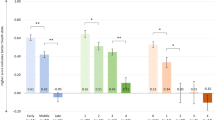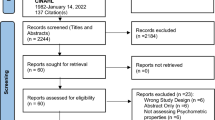Abstract
Objective
Patient reported outcome measures (PROMs) can provide researchers with a direct view of patients’ experiences. They are becoming increasingly important tools for evaluating clinical care and research outcomes. There has been little data on the application of PROMs to amyotrophic lateral sclerosis (ALS) care. The objective of this study was to examine the feasibility of PROM collection in an academic ALS clinic and to measure correlations between PROMs and standard ALS clinical outcome measures.
Methods
PROMs were gathered from tablet-based surveys offered to adult patients in the waiting room, prior to ALS outpatient clinic visits. They included a demographic section and two validated surveys: the patient reported outcome measurement information system (PROMIS-10), which generates physical health and mental health subscores, and the quality of life in neurological disorders-fatigue subscale (NeuroQoL-fatigue). The ALS functional rating scale-revised (ALSFRS-R) and other ALS measures were collected by clinic staff as part of routine clinical care.
Results
PROMIS-10 physical and mental health scores correlated positively with the ALSFRS-R score (physical: R = 0.85, p < 0.001; mental: R = 0.58, p = 0.02). NeuroQoL-fatigue scores were inversely correlated with the ALSFRS-R scores—higher fatigue correlated with lower function (R = − 0.72, p = 0.004).
Conclusion
Collection of PROMs is feasible in the context of routine ALS care. PROM scores are highly correlated with validated ALS outcome measures.



Similar content being viewed by others
Data availability
The datasets generated during analysis of this study are available from the corresponding author on reasonable request.
References
Cella D, Yount S, Rothrock N et al (2007) The Patient-Reported Outcomes Measurement Information System (PROMIS): progress of an NIH Roadmap cooperative group during its first two years. Med Care 45:S3–S11
Cella D, Riley W, Stone A et al (2010) The Patient-Reported Outcomes Measurement Information System (PROMIS) developed and tested its first wave of adult self-reported health outcome item banks: 2005–2008. J Clin Epidemiol 63:1179–1194
Moura LM, Schwamm E, Moura Junior V et al (2016) Feasibility of the collection of patient-reported outcomes in an ambulatory neurology clinic. Neurology 87:2435–2442
Schaffler N, Schonberg P, Stephan J, Stellmann JP, Gold SM, Heesen C (2013) Comparison of patient-reported outcome measures in multiple sclerosis. Acta Neurol Scand 128:114–121
Heatwole C, Bode R, Johnson N et al (2012) Patient-reported impact of symptoms in myotonic dystrophy type 1 (PRISM-1). Neurology 79:348–357
Heatwole C, Johnson N, Bode R et al (2015) Patient-reported impact of symptoms in myotonic dystrophy type 2 (PRISM-2). Neurology 85:2136–2146
Jacobi H, du Montcel ST, Bauer P et al (2018) Long-term evolution of patient-reported outcome measures in spinocerebellar ataxias. J Neurol 265:2040–2051
Mongiovi P, Dilek N, Garland C et al (2018) Patient reported impact of symptoms in spinal muscular atrophy (PRISM-SMA). Neurology 91:e1206–e1214
Abdulla S, Vielhaber S, Korner S et al (2013) Validation of the German version of the extended ALS functional rating scale as a patient-reported outcome measure. J Neurol 260:2242–2255
Smith RA, Macklin EA, Myers KJ et al (2018) Assessment of bulbar function in amyotrophic lateral sclerosis: validation of a self-report scale (Center for Neurologic Study Bulbar Function Scale). Eur J Neurol 25:907
Stephens HE, Joyce NC, Oskarsson B (2017) National study of muscle cramps in ALS in the USA. Amyotroph Lateral Scler Frontotemporal Degener 18:32–36
Vogt S, Petri S, Dengler R, Heinze HJ, Vielhaber S (2018) Dyspnea in amyotrophic lateral sclerosis (ALS): Rasch-based development and validation of a patient-reported outcome (DALS-15). J Pain Symptom Manage 56:736–745
Cedarbaum JM, Stambler N, Malta E et al (1999) The ALSFRS-R: a revised ALS functional rating scale that incorporates assessments of respiratory function. BDNF ALS Study Group (Phase III). J Neurol Sci 169:13–21
Gordon PH, Miller RG, Moore DH (2004) Alsfrs-R. Amyotroph Lateral Scler Other Motor Neuron Disord 5(Suppl 1):90–93
Andrews JA, Meng L, Kulke SF et al (2018) Association between decline in slow vital capacity and respiratory insufficiency, use of assisted ventilation, tracheostomy, or death in patients with amyotrophic lateral sclerosis. JAMA Neurol 75:58–64
Shefner JM, Liu D, Leitner ML et al (2016) Quantitative strength testing in ALS clinical trials. Neurology 87:617–624
Ludolph A, Drory V, Hardiman O et al (2015) A revision of the El Escorial criteria—2015. Amyotroph Lateral Scler Frontotemporal Degener 16(5–6):291–292
Broderick JE, DeWitt EM, Rothrock N, Crane PK, Forrest CB (2013) Advances in patient-reported outcomes: the NIH PROMIS((R)) measures. EGEMS (Wash DC) 1:1015
Hays RD, Bjorner JB, Revicki DA, Spritzer KL, Cella D (2009) Development of physical and mental health summary scores from the patient-reported outcomes measurement information system (PROMIS) global items. Qual Life Res 18:873–880
Cella D, Lai JS, Nowinski CJ et al (2012) Neuro-QOL: brief measures of health-related quality of life for clinical research in neurology. Neurology 78:1860–1867
Gershon RC, Lai JS, Bode R et al (2012) Neuro-QOL: quality of life item banks for adults with neurological disorders: item development and calibrations based upon clinical and general population testing. Qual Life Res 21:475–486
Knudson RJ, Lebowitz MD, Holberg CJ, Burrows B (1983) Changes in the normal maximal expiratory flow-volume curve with growth and aging. Am Rev Respir Dis 127:725–734
Gibbons C, Pagnini F, Friede T, Young CA (2018) Treatment of fatigue in amyotrophic lateral sclerosis/motor neuron disease. Cochrane Database Syst Rev 1:CD011005
Krupp LB, LaRocca NG, Muir-Nash J, Steinberg AD (1989) The fatigue severity scale. Application to patients with multiple sclerosis and systemic lupus erythematosus. Arch Neurol 46:1121–1123
Paganoni S, Cudkowicz M, Berry JD (2014) Outcome measures in amyotrophic lateral sclerosis clinical trials. Clin Investig (Lond) 4:605–618
Kelly L, Jenkinson C, Morley D (2015) Outcome measurement in neurodegenerative disease: attributes, applications & interpretation. Neurodegener Dis Manag 5:305–316
Dirven L, Taphoorn MJ, Reijneveld JC et al (2014) The level of patient-reported outcome reporting in randomised controlled trials of brain tumour patients: a systematic review. Eur J Cancer 50:2432–2448
Jonsson AC, Delavaran H, Iwarsson S, Stahl A, Norrving B, Lindgren A (2014) Functional status and patient-reported outcome 10 years after stroke: the Lund Stroke Register. Stroke 45:1784–1790
Markman JD, Gewandter JS, Frazer ME et al (2015) Evaluation of outcome measures for neurogenic claudication: a patient-centered approach. Neurology 85:1250–1256
Acknowledgements
We would like to thank all study participants and their families and caregivers for their dedication and contribution to ALS research.
Funding
No targeted funding.
Author information
Authors and Affiliations
Corresponding author
Ethics declarations
Conflicts of interest
Fabiola De Marchi: reports no disclosure. James D. Berry has been a consultant to Denali Therapeutics and has research funding from Amylyx Pharmaceuticals, Anelixis Pharmaceuticals, Biogen, Brainstorm Cell Therapeutics, Genentech, MT Pharma of America, ALS Association, ALS Finding A Cure, ALS One, EGL Foundation, and Muscular Dystrophy Association. James Chan: reports no disclosure. Sarah Caldwell: reports no disclosure. Amy Ellrodt: reports no disclosure. Jennifer Scalia: reports no disclosure. Katherine Burke: reports no disclosure. Ton Fang: reports no disclosure. Rachel Clark Sisodia: reports no disclosure. Lidia M.V.R. Moura: reports no disclosure. Lee Schwamm: reports no disclosure. Sabrina Paganoni has received research funding from the Salah Foundation, the Spastic Paraplegia Foundation, the ALS Association, ALS Finding a Cure, the American Academy of Neurology and Amylyx.
Ethical statement
This study has been approved by the appropriate ethics committee and has, therefore, been performed in accordance with the ethical standards (Declaration of Helsinki). In particular, this retrospective chart review and analysis was approved by the Partners Healthcare Human Research Committee.
Rights and permissions
About this article
Cite this article
De Marchi, F., Berry, J.D., Chan, J. et al. Patient reported outcome measures (PROMs) in amyotrophic lateral sclerosis. J Neurol 267, 1754–1759 (2020). https://doi.org/10.1007/s00415-020-09774-8
Received:
Revised:
Accepted:
Published:
Issue Date:
DOI: https://doi.org/10.1007/s00415-020-09774-8




